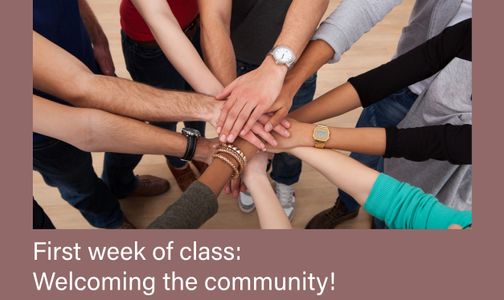First week of class: Welcoming the Community!

Contributed by CTL staff
(2 minute read)
As you meet your students online or in person this week, we recommend you have an intentional and purposeful approach for welcoming your students to the learning environment and building community in your classroom. When students feel that they are welcomed members of a group and part of a community, they are more likely to engage in the classroom. Intentionally fostering a sense of community is particularly important in remote and hybrid modalities when students may feel isolated due to their lack of physical presence in the classroom.
Below are several strategies that can be integrated into your class without much advance preparation:
- Ice-breakers: Warm up the first day of class in a way that students feel welcome, included and valued. Ice-breaker activities are a great way to build class community the first day. View our Fostering Classroom Community Lightning Talk series recording for Thomas Underwood’s (CAS Writing Program) strategies for “Ice-breakers and Community in Zoom Classrooms”.
- Collaboration with Messaging Tools: Create a collaboration space with a messaging tool such as Pronto. You may set up this space before the first day of class, and ask students to post a message or a short 1-2 minute video introducing themselves, talking about their hobbies, showing where they are in the world, etc. Pronto is conveniently integrated into Blackboard, and has a mobile app as well. Read this Digital Learning & Innovation POV on how instructors at BU instructors Amy Shanler and Ann Danehy (College of Communication) have been using Pronto to build community and increase student engagement.
- Scavenger Hunt: Have students complete a scavenger hunt of your course syllabus and/or course website. For example, you could ask students to look for specific information regarding assignments, deadlines, attendance policy, etc. If possible, allocate some dedicated class time for this activity with a Q&A follow-up after. This is a great way to ensure students are reviewing the syllabus in detail. Students may do this in teams, and if they are remote, in break-out rooms. Small incentives (one-day extension on a homework or suggesting a bonding activity during class, etc) always help with building up the competition!
- Student Sub-groups: Depending on your class size, you may create student sub-groups that will remain a group for the entire semester. These groups are not the small groups you may have during an in-class activity, rather they are support groups. These sub-groups are in charge of helping one another out, collaborating, etc. You may recommend your sub-groups set up study hours to meet online and study together. These groups are meant to be casual, and do not impact students’ grades.
- Favorite Soundtracks: Collect students’ favorite soundtracks and play one soundtrack per class session before class, during group work (if not distracting to students) or at the end of class. Read more about the benefits of playing music before class in this CTL News & Announcements contribution by Deb Breen where she reflects on how she was inspired by the work of two colleagues Irit Kleiman (Romance Studies) and Stephen Donweber (Law) and how they implement music into their courses.